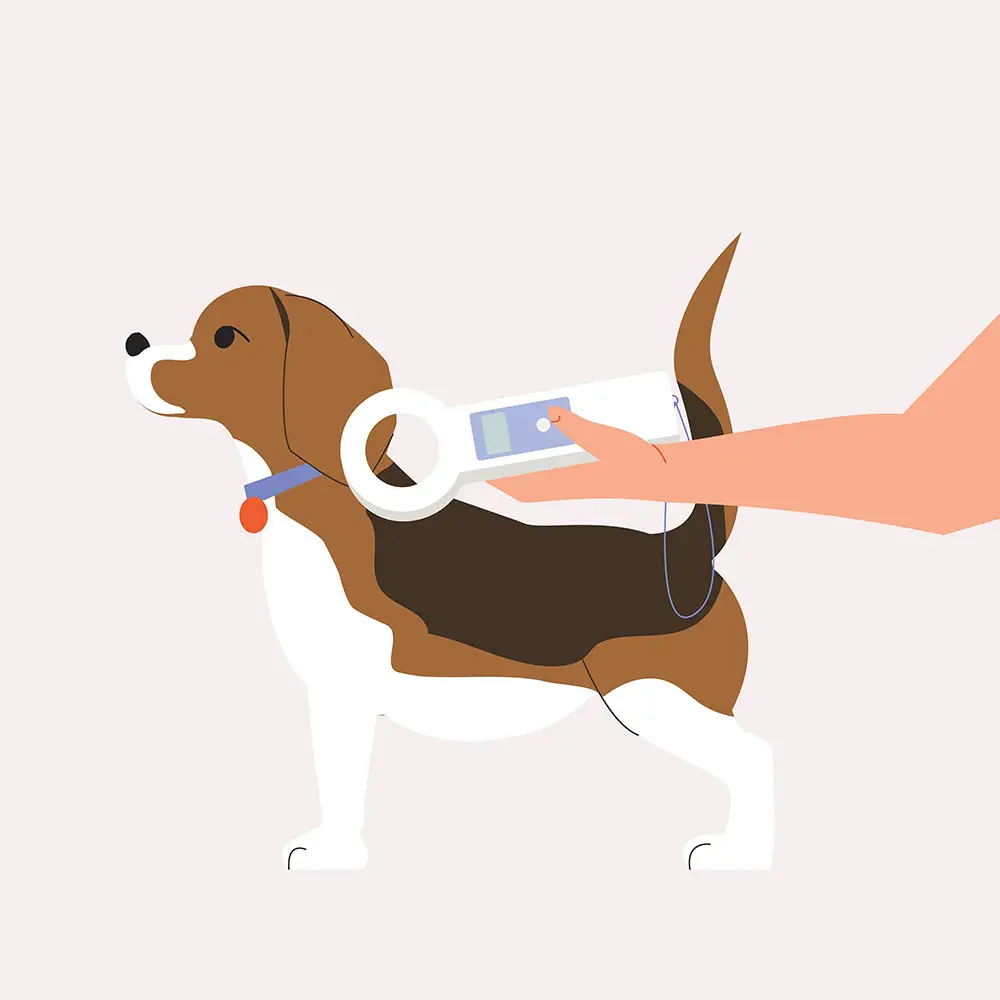Undoubtedly, a pet is like a family member, and it’s devastating if your dog gets lost or runs away. You may have heard of GPS tracking chips for dogs and wondered how these devices could help trace your lost pet.
This article explains these devices, how they work, the different types of dog tracking devices, and why you need one.
Table of Contents
- What Is a GPS Dog Tracking Chip and How Does it Work?
- Types of GPS Dog Trackers
- GPS Tracking Collars for Dogs
- Microchips Vs. GPS Trackers
- FAQS
- Conclusion
What Is a GPS Dog Tracking Chip and How Does it Work?
A GPS dog tracking device has elaborate technology to help identify your contact information should your dog run away or get lost.
It comprises a microchip that‘s inserted under the dog’s skin. Don’t worry. The microchip is tiny in size, like a grain of rice, and inserting it involves a quick and next to painless injection.
Each microchip carries a unique number that’s linked to your contact details.
And when the dog gets spotted somewhere, you can read the owner’s contact information using a scanning device known as RFID (radio frequency identification).

(Caption: Image of a dog being scanned)
Animal shelters and clinics routinely scan stray or lost animals for these microchips to identify their owners, after which they can contact them.
Types of GPS Dog Trackers
The dog-tracking technology market offers various types of devices.
The devices have pros and cons, making it important to consider your needs before choosing the one that best serves them. These devices include;
Implanted Microchips
Implanted microchips are ideal for all sizes of dogs. These microchip dog GPS hold your contact information to help to connect your dog should you become separated one day.
Microchips don’t have activity-tracking devices.
If you lose your dog and someone finds it, they will take it to an SPCA (Society for the Prevention of Cruelty to Animals), pet clinic, or vet office to scan it and establish if the scanner picks up the implant.
If you’ve updated your contact information with one or more relevant sites, the scanning professional will contact you to set up a reunion with your dog.

(Caption: Image of device reading contact information)
Radio Frequency Trackers
Radiofrequency trackers can provide a general location of the place from where your dog is using the specific signals.
These signals are effective over short distances, making radio frequency trackers the best option in suburban neighborhoods when you can quickly locate your dog.
You’ll have the transmitter base while your dog carries the tracking device tag on its collar.
The tag connects the signal to the location whenever you send transmitted signals.
Radio signals are more effective in straight lines and around objects with the capability of bouncing the signal off to the source.
Note that radio frequency signals can’t go through blocking objects and walls.
GPS Dog Trackers
GPS dog trackers are bulkier than most available dog tracking devices. These trackers use GPS technology (mostly cellular) to transfer your pet’s location data to your smartphone.
The geographical coverage of GPS dog trackers is limited to cellular network availability.
The GPS trackers are effective within cellular range coverage, and detecting the dog’s exact location relies on network availability.
The biggest advantage of GPS trackers is their ability to work over longer distances as long as the area has access to network coverage.
GPS Dog Trackers
GPS dog trackers are bulkier than most available dog tracking devices. These trackers use GPS technology (mostly cellular) to transfer your pet’s location data to your smartphone.
The geographical coverage of GPS dog trackers is limited to cellular network availability.
The GPS trackers are effective within cellular range coverage, and detecting the dog’s exact location relies on network availability.
The biggest advantage of GPS trackers is their ability to work over longer distances as long as the area has access to network coverage.
GPS Tracking Collars for Dogs

(Caption: Image of GPS dog collar)
Your dog can’t get lost in the neighborhood with a GPS tracking collar for dogs. Sometimes your dog may wander too far to return home, especially if you’re used to keeping your dog mostly indoors.
The functionality of GPS depends on highly sophisticated satellites, each continuously broadcasting signals.
The receivers are on the ground, including a GPS-tracking gadget embedded in your dog’s collar.
GPS tracking collars for dogs are similar to GPS trackers that game rangers use when tracking wildlife migration.
These trackers can help you trace your lost dog within minutes.
Microchips Vs. GPS Trackers
The following summary offers the differences between microchips and GPS dog trackers.
Functionality
Microchips and GPS dog trackers serve two distinct purposes. A microchip helps a person to identify their dog using the ID number.
A GPS, on the other hand, assists you in locating your dog actively in real time.
Hardware
GPS and microchip devices use different hardware components to perform their unique functions.
For instance, the primary purpose of a microchip is to provide an ID number linked to your dog, while the GPS offers vast features that assist you in locating your dog.
A microchip contains a small electronic chip encased in a glass cylinder.
A GPS tracker has components such as GPS antennae, GPS tracker, battery pack, GPS antennae, SIM card, and LED light.
Size
The difference in hardware components significantly affects the size of a microchip and GPS tracker.
A microchip is the size of a grain of rice because it contains an electronic chip that needs reading by an RFID scanner.
GPS trackers, on the other hand, must be bigger to accommodate relevant hardware components.
A typical GPS tracker measures 72 x 29 x 16 mm with an approximate weight of 30 grams.
The current technology is yet to allow the devising of GPS in microchip form.
FAQS
Are there GPS microchips for dogs?
Microchips don’t have GPS capability because GPS trackers are way bulkier than microchips with their various components (GSM module, loudspeaker, LED light, GPS antenna, and battery pack).
A GPS device requires general mobile phone coverage (GSM) and positioning system connections.
Do dog microchips have GPS?
Dog microchips lack GPS technology. These devices rely on radio-identification frequency technology that the vet scans for the dog owner’s contact information.
As a result, microchips don’t provide your dog’s specific location.
How much are GPS dog trackers?
An average GPS tracker such as Tractive pet GPS costs approximately $50 with a $5 monthly subscription.
However, most pets charge less than $50 to implant a microchip in your dog.
What are the different types of GPS dog trackers?
There are three main types of GPS trackers. Most GPS-equipped phones can work effectively with any of the following modes depending on your installed mobile applications.
- Data pushers
- Covert GPS trackers
- Data pushers
- Data loggers
Conclusion
Microchips and GPS trackers for dogs are essential to uniting your lost dog.
Dogs have no microchip GPS, but you can use GPS tracking collars to determine your pet’s specific location.
However, you can also combine the two methods to enhance the process of locating your lost dog.
An economical combination option is getting a microchip implant and attaching a radio frequency to your dog’s collar.
